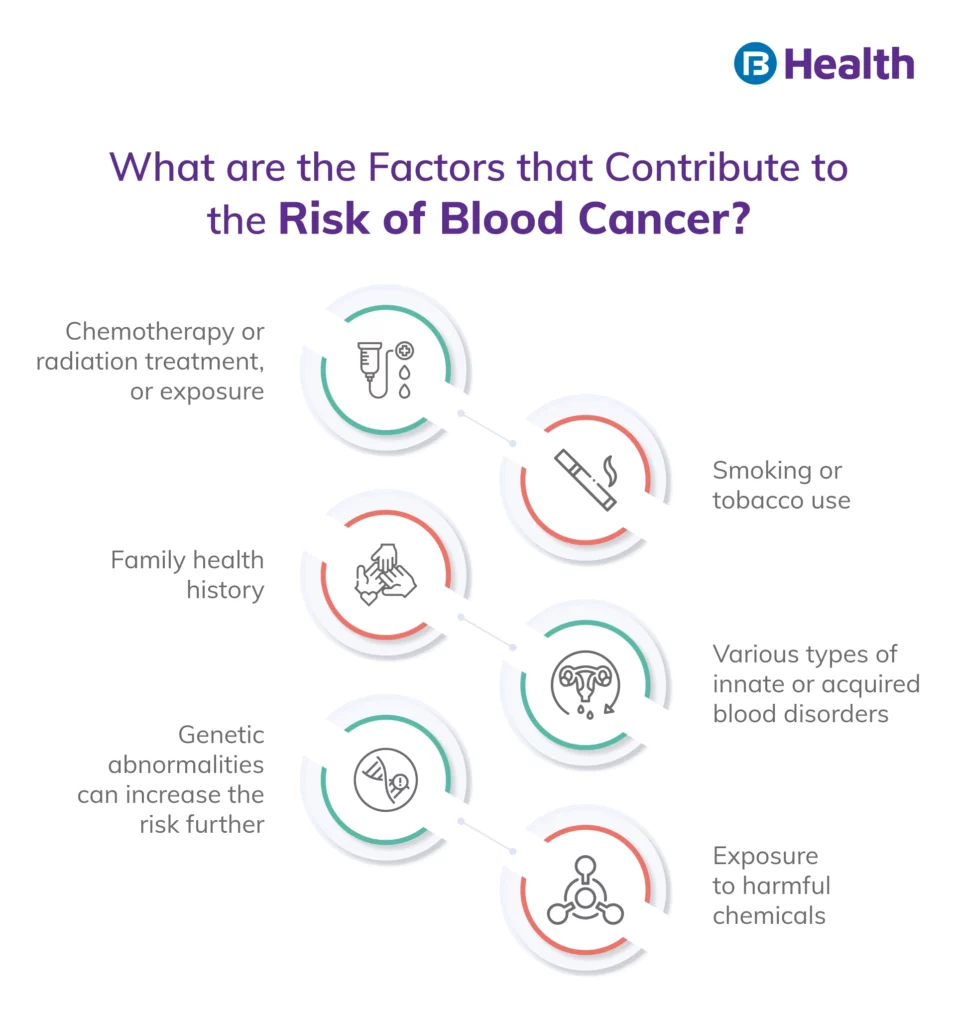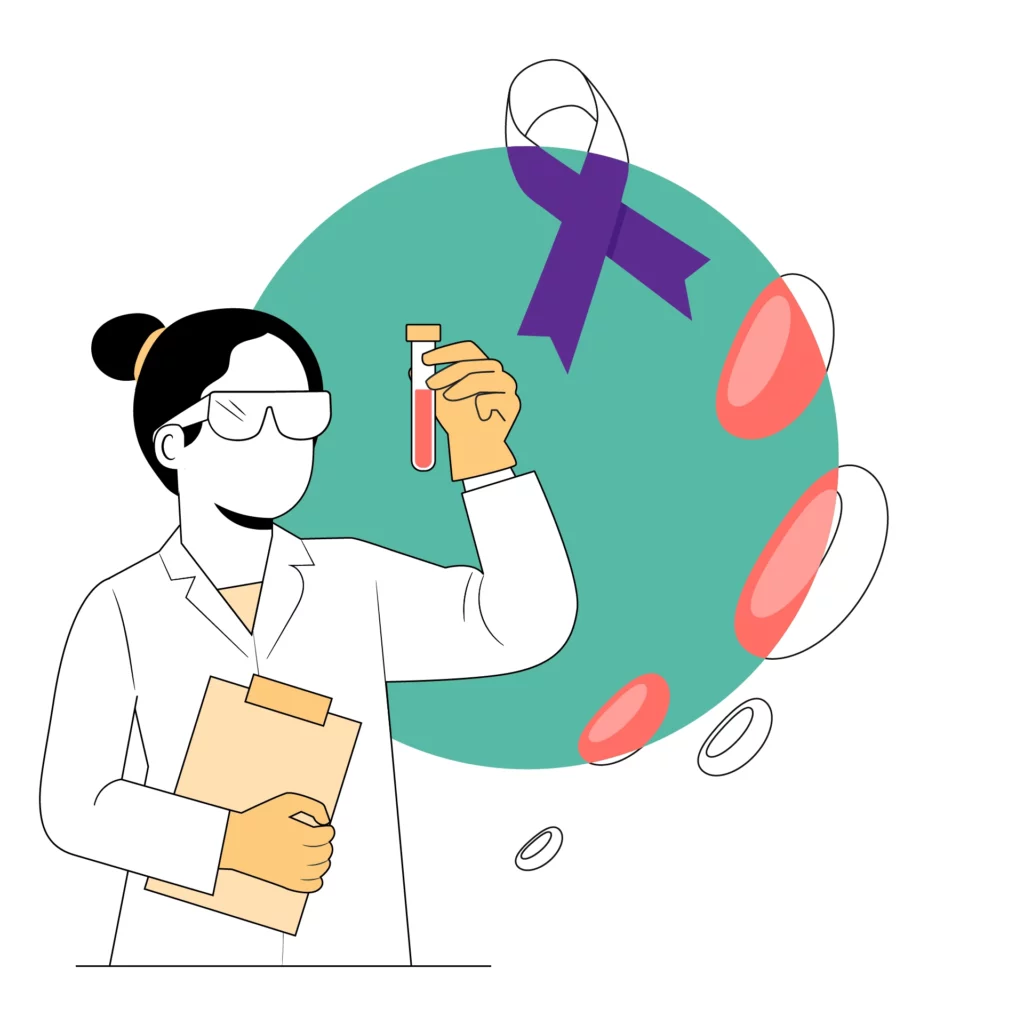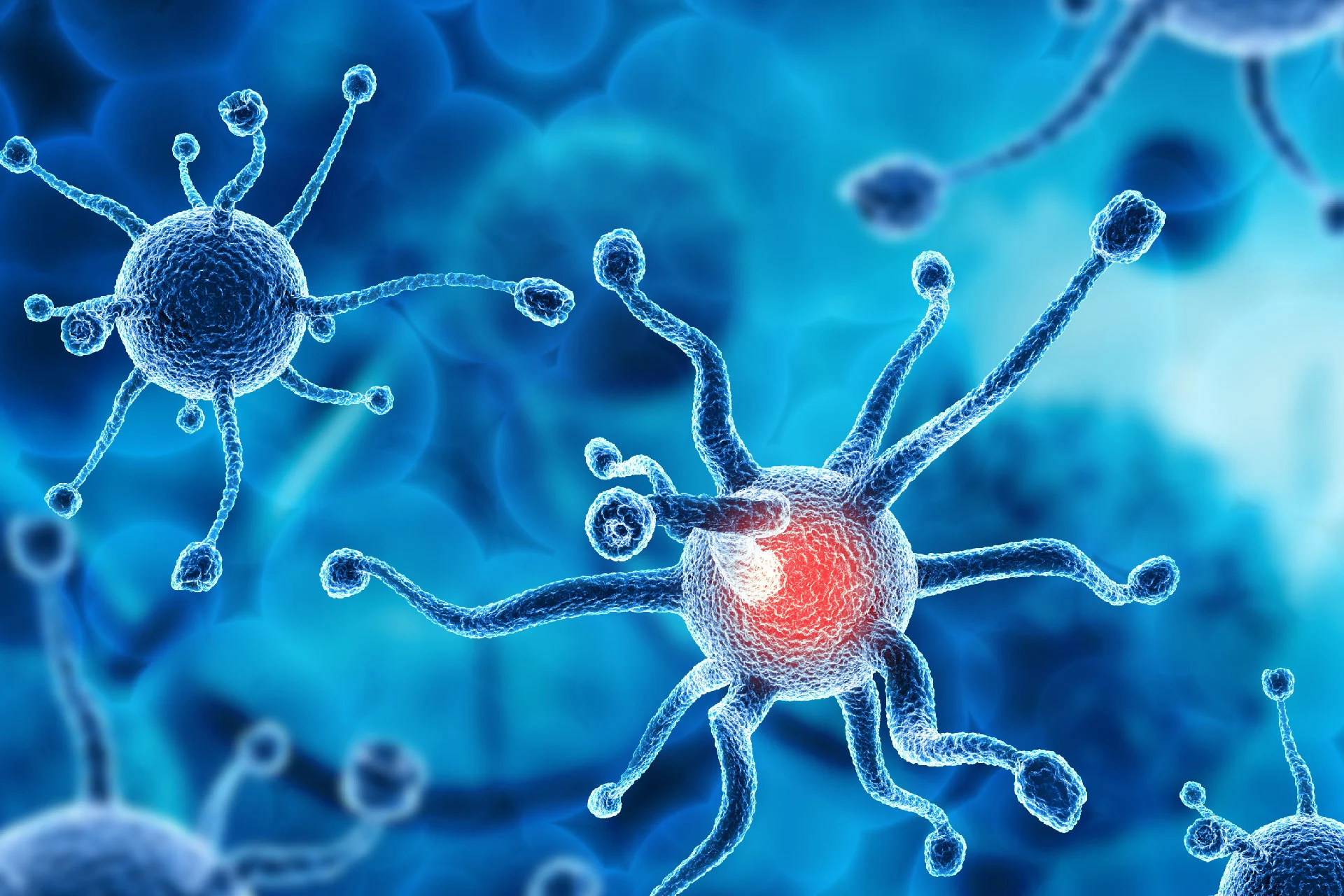Cancer | 8 min read
Blood Cancer: Early Symptoms, Causes, Stages, Diagnosis
Medically reviewed by
Table of Content
Synopsis
The majority of blood cancers, also known as hematologic cancers, begin in the bone marrow, where blood is created. Blood cancers develop when abnormal blood cells expand uncontrollably and interfere with the regular blood cells' ability to fend off infection and generate new blood cells.
Key Takeaways
- Although blood cancers are severe conditions, some cancers are more lethal
- An estimated 3% of all cancer-related deaths are thought to be caused by blood cancers [6]
- Data from the National Cancer Institute indicates a consistent decrease in blood cancer fatalities
Blood cancer has an impact on both the production and functionality of blood cells in your body. The soft, sponge-like substance in the middle of your bones, called bone marrow, is where the majority of blood malignancies begin. Your bone marrow produces stem cells that eventually mature into red blood cells, platelets, and white blood cells.
Normal blood cells control bleeding, transport oxygen throughout the body, and fight infection. Blood cancer develops when your body's ability to produce blood cells is disrupted. When you have blood cancer, abnormal blood cells outnumber healthy blood cells, which leads to an avalanche of illnesses. As medical professionals discover novel treatments for blood cancer, more people are surviving longer with the disease.
Types of Blood Cancer
Leukemia, lymphoma, and melanoma are the three main Blood cancer types. These can also occur in bone marrow:
Leukemia
A blood cancer type called leukemia develops in the bone marrow and blood. It happens when the body produces excessive aberrant white blood cells, interfering with the bone marrow's production of platelets and red blood cells. It can spread to other parts of the body.
Non-Hodgkin lymphoma
Blood cancer, known as non-Hodgkin lymphoma, is caused by lymphocytes, a type of white blood cell that aids in the body's ability to fight infections.
Hodgkin lymphoma
It is a blood cancer that arises from lymphocytes, which are lymphatic system cells. The Reed-Sternberg cell, an aberrant lymphocyte, is a defining feature of Hodgkin lymphoma.
A type of white blood cell generated in the bone marrow called a plasma cell is where multiple myeloma, blood cancer, starts. Study the progression of multiple myeloma as well.
Additionally, there are fewer common malignancies of the blood and bone marrow as well as related diseases, such as:
- Myelodysplastic syndromes (MDS): These are uncommon diseases that may be brought on by harm to the bone marrow's blood-forming cells
- Myeloproliferative neoplasms (MPNs): These uncommon blood malignancies are brought on by excessive production of platelets, red blood cells, or white blood cells. The three primary subgroups are polycythemia Wera (PV), myelofibrosis, and essential thrombocythemia (ET)
- Amyloidosis: This uncommon condition is not a type of cancer and is defined by the accumulation of an aberrant protein called amyloid. But it has a close relationship with multiple myeloma
- Waldenstrom macroglobulinemia: This is a rare non-Hodgkin lymphoma that develops in B cells
- Aplastic anaemia: This is a rare illness that arises when critical stem cells are destroyed and can only be repaired with a bone marrow transplant

What causes blood cancer?
The DNA of blood cells can change or mutate, which causes blood cancer, but researchers don't know why this occurs. Your DNA gives instructions to cells. In blood cancer, the DNA instructs blood cells when to grow, divide, multiply, and die.
Your body creates aberrant blood cells that grow and reproduce more quickly than usual and occasionally live longer than expected when DNA provides your cells with new instructions. When that occurs, your regular blood cells are forced to compete for space in your bone marrow with an ever-expanding horde of aberrant cells.
Your bone marrow gradually generates fewer normal cells. This indicates that there aren't enough healthy cells available to carry out their fundamental functions, like supplying your body with oxygen, warding off infection, and managing to bleed. Here are three potential genetic blood cancer causes of the three forms of blood cancer:
Leukaemia
According to researchers, leukaemia develops when a number of inherited and environmental variables interact to cause DNA alterations [1]. In this instance, scientists believe that chromosome changes may be the cause of DNA modifications. Strands of DNA make up chromosomes. These DNA strands are duplicated when cells divide to form two new cells. Genes from one chromosome can occasionally move to another. This transition may have an impact on a group of genes that promote cell growth and a different group of genes that repress malignancies in leukaemia. Researchers think that the genetic alterations that lead to leukaemia are influenced by exposure to high doses of radiation or specific chemicals [2].
Lymphoma
Lymphoma develops when the genes of white blood cells called lymphocytes are altered, leading to an uncontrollable increase in their number. Additionally, when normal cells pass away, aberrant lymphocytes do not. Again, the cause of the genetic shift is unknown, although research suggests that some illnesses or having a weakened immune system may play a role.
Myeloma
In this situation, plasma cells in your bone marrow obtain new genetic instructions that make them multiply. Researchers are looking into possible connections between myeloma and chromosomal changes that impact the genes that govern the development of plasma cells [3].
Early Signs of Blood Cancer
In its early stages, blood cancer typically exhibits no distinctive symptoms. However, the following warning signs and symptoms are concerning, so you should discuss them with your doctor:
Lumps and swelling:
Unusual masses or lumps may develop in the lymph nodes, including the testicles, tonsils, or armpits, causing discomfort
Rectal bleeding:
While urinating, bloody discharge is possible
Changes in urination patterns:
Blood in the urine or a burning sensation in urine are common symptoms of hematuria
Pallor:
Due to an inadequate supply of red blood cells in their bodies, people with blood malignancies may seem extremely pale
Symptoms of Blood Cancer
Despite the fact that each kind of blood cancer is unique, they might have some similar symptoms and warning signs.
Some blood cancer patients might not exhibit any symptoms until the condition has progressed. Or they might think they have the flu or a terrible cold.
- Coughing or chest discomfort: An accumulation of abnormal blood cells in your spleen could be the culprit
- Recurring infections: Lack of sufficient white blood cells to combat common pathogens may be the cause
- Chills or a fever: Lack of white blood cells, which causes infections to occur more frequently, is one potential explanation
- Unexpected bleeding, bruising, or rash: Lack of platelets, which are the cells that aid in blood clotting, may be the cause
- Skin itchiness: Unknown reasons could be involved
- Nausea or a loss of appetite: A buildup of abnormal blood cells that puts pressure on your stomach and causes your spleen to enlarge could be one potential explanation.
- Night sweats: Unknown reasons could be involved
- Persistent weariness and weakness: A possible factor is a lack of red blood cells (anaemia)
- Shortness of breath: Anaemia could be the reason
- Swollen, painless lymph nodes in the groin, armpits, or neck: Your lymph glands may have accumulated abnormal white blood cells, which is a potential cause
How is blood cancer diagnosed?
Your cancer care team will perform blood cancer tests to determine the type and stage of your disease. Staging and diagnosis frequently occur simultaneously.
The following tests and techniques may be used to diagnose blood cancers:
- Blood tests
- Bone marrow testing
- Imaging tests such as the CT scan, PET scan, and X-ray
- Physical examination
- Surgical excision of lymph nodes (to use in staging)
The process of staging reveals the extent and seriousness of a malignancy. In addition, it clarifies the precise type, location, and spread of cancer for every care team member. By gauging tumour size and disease progression, doctors stage solid tumours (such as lung cancer or ovarian cancer). Blood tumours, however, are distinct.
Blood Cancer Stages
Your cancer specialist will go over how they determine your blood cancer's stage, and blood cancer staging often considers:
- Counts of blood cells, including the number of healthy cells
- Dimensions and count of cancer cells
- Mutations in the cancer cells' genes
- Other organs harbouring cancerous cells
- Bone injury (with leukaemia and multiple myeloma)
- Enlarged spleen or liver

How Is Blood Cancer Treated?
Chemotherapy:
Chemotherapy is the main treatment for blood cancer, destroying cancer cells to either stop cancer from spreading or to limit its progression. Healthcare professionals use different drug classes for various blood cancers. Radiation Therapy:
Medical professionals can treat leukaemia, lymphoma, and myeloma with radiation therapy. Radiation that hits aberrant cells damages their DNA, preventing them from proliferating. Radiation therapy is frequently administered in conjunction with other treatments. In addition, radiation therapy may be used to treat some symptoms.
Immunotherapy
Immunotherapy may assist your body in producing more immune cells or help your current immune cells locate and eliminate cancerous cells.
Cancer-targeted therapy
This cancer treatment targets genetic alterations or mutations that cause healthy cells to become abnormal cells.
CAR T-cell therapy
Medical professionals can treat cancer more successfully using this type of white blood cell, known as a T-cell lymphocyte. Medical professionals may employ CAR T-cell therapy to treat B-cell acute lymphoblastic leukaemia, multiple myeloma, and several forms of non-Hodgkin's lymphomas if other treatments have failed.
More people than ever before are coping with blood cancer because of new and better treatments. Researchers and medical professionals are getting closer to curing some blood cancers. But blood cancer is a serious condition, and finding out you have a blood cancer type is a serious matter. If you have blood cancer, please get in touch with Bajaj Finserv Health to book an online appointment. With the help of an oncologist consultation, you can have all your queries concerning blood cancer addressed. Contact us right away to live a cancer-free healthy life!
References
- https://www.ncbi.nlm.nih.gov/pmc/articles/PMC8125807/
- https://www.ncbi.nlm.nih.gov/pmc/articles/PMC3447593/
- https://aacrjournals.org/cancerres/article/64/4/1546/512173/Genetics-and-Cytogenetics-of-Multiple-MyelomaA
Disclaimer
Please note that this article is solely meant for informational purposes and Bajaj Finserv Health Limited (“BFHL”) does not shoulder any responsibility of the views/advice/information expressed/given by the writer/reviewer/originator. This article should not be considered as a substitute for any medical advice, diagnosis or treatment. Always consult with your trusted physician/qualified healthcare professional to evaluate your medical condition. The above article has been reviewed by a qualified doctor and BFHL is not responsible for any damages for any information or services provided by any third party.





